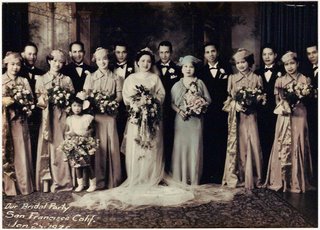All that remains of the [Barbary] Coast's previous glory are the crumbling ruins of flashy entrances that once lured the unwary to his plucking. The Thalia Dance Hall is now the Thalia Garage, and in the basement of the old Moulin Rouge an Employment Office operates in the spring of the year to sign up Mexican and Filipino help for the Alaskan fish canneries. A cafeteria occupies the site of one of the most notorious old dance-halls, while respectable Chinese families have taken possession of the transient rooming-houses which in their prime did not boast savory reputations. I suspect, in the dry days, some of its soda fountains were speak-easies in soft-drink clothing but repeal has placed them even beyond pretense. Even the contiguous territory that once threw out a diluted abandon has faded to drab respectability. Upper Kearny Street now swarms with male Filipinos. It is not precisely a Filipino quarter, for Filipinos belong to the fifty-dollar-a-month-and-found class who go out to service in private homes and run the elevators for apartment houses. They likewise go down to the sea in ships as stewards and waiters and cabin-boys. Natty, slick dandies they are, with sleek and shining hair, pinch-back coats, and twenty-four inch trousers flopping in the breeze. The poolrooms, the barber shops, the photograph galleries are always crowded with them. Filipinos seem always to be playing pool or going to barbers or having their pictures taken.
I am so intrigued by this. Yes, Mr. Dobie has affected a condescending tone and committed the sin of gross generalization. And, yes, it is clear that these Filipino men have been observed only from afar like animals in the zoo. However, there is none of the vitriol we've come to expect from Americans writing about Filipinos in the 20s and 30s. No inflammatory descriptions of oversexed Pinoys and their insatiable lust for white women, no complaints about alleged 'criminal' behavior, no reference to taking jobs that belong to others, or to their all-around moral degeneracy. Here, Filipinos are only accused of having low-paying jobs, living in cheap rooms, and being incredibly vain.
Mr. Dobie is almost surely dead by now, but on the off-chance that he's not and that he has internet access and an interest in googling his name, I want him to know that these are my maternal grandparents at their 1936 wedding in San Francisco.

Lolo was a student at USF and then worked in a shampoo factory; Lola owned her own sewing shop just off Clement St. They bought a house on 9th Ave. (purchased under the name of some Irish friends) in the Richmond District, and then two on 14th Ave. So, allow me to refute Mr. Dobie's descriptions:
1) Bad jobs? No, good jobs!
2) Bad living quarters? No, good living quarters!
3) Vain? Well...okay, yes! Based on my personal experience with Lolo—specifically his channeling of Rudolph Valentino—Mr. Dobie was spot-on there.
6 comments:
v, this is so interesting! thanks for posting on mr. dobie's book, and i love the photo.
Wow, thanks! I hope you don't mind if I use this information for my novel set in San Francisco in the early 1930s. The stuff about the dance hall and where Filipinos were working, and going to school is priceless. Are your grandparents still around? They must've been in SF during the big "Bloody Thursday" strike, which shut the whole city down.
Hi Gladys & Jean!
Yes, Jean, go ahead and use away! And, no, my grandparents are no longer hanging about; they passed away a few years back. You should pick up a copy of San Francisco A Pageant—a used copy is only 8 bucks at Green Apple. It's filled with stuff you can use, plus there are great illustrations...
Thanks for the tip, Ver. I'm definitely going to get a copy of that book...
J
ver! 1st of all, gorgeous picture. thanks for posting.
so dobie portrays filipinos almost like insects, it's disturbing. btw is this a book of fiction? not like this'd make it any better, but i thought i'd ask.
Hi Ms. BJ! I love this picture. Lola sewed all those dresses!
Okay, so my response to Mr. Dobie's description is basically the equivalent of settling for scraps, but I feel that considering the political climate at the time the book was published, he is remarkably...not that mean. Just (as I said) condescending and writing at a snooty remove from his subjects. I dunno.
And let's see...as of 1933, Dobie had published seven works of fiction and 2 of nonfiction, including the one I refer to here. The other is San Francisco's Chinatown. Hmmmm...
Post a Comment